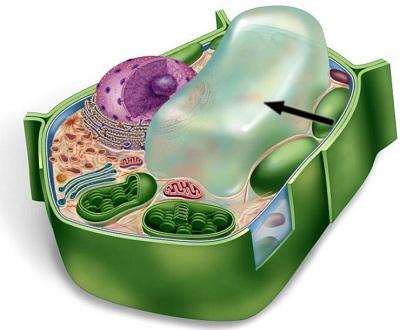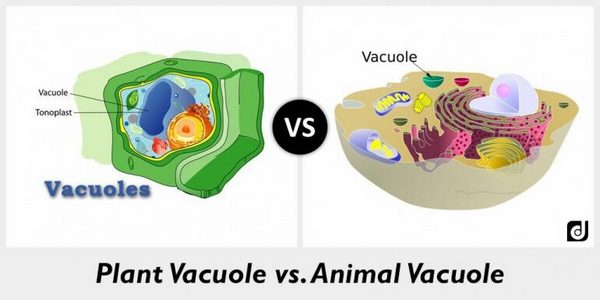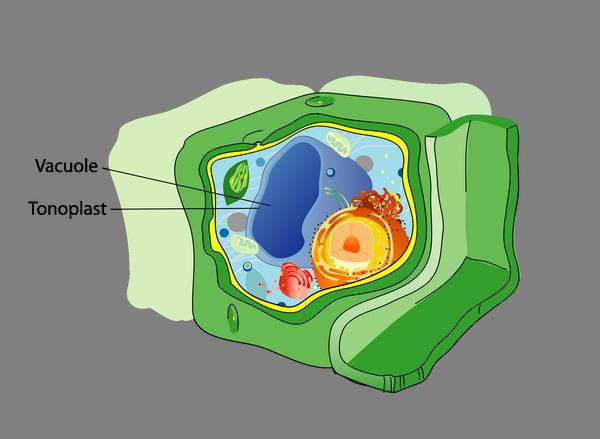Vacuole

Content:
Definition
Vacuoles are one-membrane cellular organelles and important components of a eukaryotic cell (the eukaryotic cell has a nucleus and a membrane – outer shell). However, not all eukaryotic cells have vacuoles among their organelles. Vacuoles are mainly found in plant and fungal cells. Do animal cells have vacuoles? Yes, animal cells do have vacuoles, but they are smaller, larger in number (plant cells usually have just one or a few large vacuoles) and serve a somewhat different purpose than those of plants.
Structure
All vacuoles are formed from provacoles, which in turn appear at the birth of a cell in the form of membrane bubbles. What does a vacuole look like? Look at this vacuole picture.

This is how vacuoles look in plant and animal cells. The vacuole is a large vesicle, which can occupy more than half of the total volume (especially in a plant cell).
The vacuole, like a cell, is surrounded by a protective membrane – a tonoplast. There is the cell sap inside the vacuole which is a concentrated solution of water, mineral salts, sugars, organic acids, oxygen, carbon dioxide, products of cellular metabolism, and so on.
The tonoplast of vacuoles is permeable in some places, so water enters the vacuole, due to which the vacuole begins to exert pressure on the surrounding cytoplasm (this pressure is called turgid). As a result, the cytoplasm is pressed against the cell walls. Such pressure (caused by vacuoles) helps plant cells to remain rigid and straight and generally contributes to their growth.

Function
What is the function of the vacuole? Vacuoles ensure the normal functioning of the cell and carry out a number of useful job functions:
- The cell grows thanks to the vacuoles. Vacuoles contribute to cell elongation due to a special turgor pressure on the cell walls. As we wrote above, the turgor pressure of vacuoles on the cell wall occurs due to filling vacuoles with water.
- Vacuoles store important minerals, nutrients, water, enzymes necessary for the cell and plant pigments.
- Vacuoles remove potentially toxic substances from the cell, such as heavy metals and herbicides. Besides this, the internal acidic environment of the vacuoles carries out the splitting of large molecules that interfere with the normal functioning of the cells.
Role in Plant Cell
Additionally, vacuoles in plant cells perform such functions as:
- Protection. In some plants, vacuoles emit special chemicals that are poisonous or unpleasant in the smell for some animals. Thus, the plants protect themselves.
- Vacuoles are responsible for seed germination in many plants. Important proteins, carbohydrates, and fats necessary for seed growth are stored in vacuoles. Vacuoles are a source of nutrients for seeds at the time of their germination.
References and Further Reading
- Venes, Donald (2001). Taber’s Cyclopedic Medical Dictionary (Twentieth Edition), (F.A. Davis Company, Philadelphia), p. 2287 ISBN 0-9762548-3-2.
- Heide N. Schulz-Vogt (2006). “Vacuoles”. Inclusions in Prokaryotes. Microbiology Monographs. 1. pp. 295–298. doi:10.1007/3-540-33774-1_10. ISBN 978-3-540-26205-3.
- Brooker, Robert J, et al. (2007). Biology (First Edition), (McGraw-Hill, New York), p. 79 ISBN 0-07-326807-0.
- http://pcp.oxfordjournals.org/content/50/1/151.full.pdf
- Matile, Phillipe (1993) Chapter 18: Vacuoles, discovery of lysosomal origin in Discoveries in Plant Biology: v. 1 (World Scientific Publishing Co Pte Ltd)
- Thomas Boller. Plantbiology.unibas.ch. Retrieved on 2011-09-02.
- Jezbera Jan; Karel Hornak; Karel Simek (2005). “Food selection by bacterivorous protists: insight from the analysis of the food vacuole by means of fluorescence in situ hybridization”. FEMS Microbiology Ecology. 52 (3): 351–363. doi:10.1016/j.femsec.2004.12.001. PMID 16329920.

Author: Pavlo Chaika, Editor-in-Chief of the journal Poznavayka
When writing this article, I tried to make it as interesting and useful as possible. I would be grateful for any feedback and constructive criticism in the form of comments to the article. You can also write your wish/question/suggestion to my mail pavelchaika1983@gmail.com or to Facebook.

